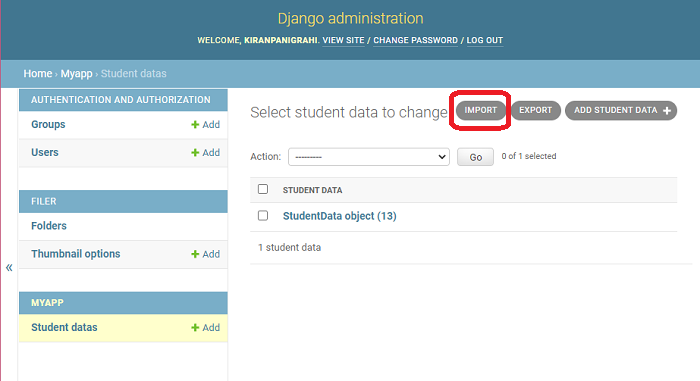
 Data Structure
Data Structure Networking
Networking RDBMS
RDBMS Operating System
Operating System Java
Java MS Excel
MS Excel iOS
iOS HTML
HTML CSS
CSS Android
Android Python
Python C Programming
C Programming C++
C++ C#
C# MongoDB
MongoDB MySQL
MySQL Javascript
Javascript PHP
PHP
- Selected Reading
- UPSC IAS Exams Notes
- Developer's Best Practices
- Questions and Answers
- Effective Resume Writing
- HR Interview Questions
- Computer Glossary
- Who is Who
Importing data into models in Django
In this article, we are going to see how to import data from json format to model. We can import data from json, csv, xlsx, yml, etc. to model.
First of all, create a Django project and an app. Set up urls and do some basic stuff like adding the app in INSTALLED_APPS.
Create a model. Here, we don't have much to do with views.py, urls.py or any html file. We only have to work with settings.py, admin.py, models.py and admin urlpoint.
Example
Install the django-import-export package −
pip install django-import-export
In settings.py, add the following line −
INSTALLED_APPS += ['import_export']
It will add import_export as an app in our project.
Create a model −
class StudentData(models.Model): name=models.CharField(max_length=100) standard=models.CharField(max_length=100) section=models.CharField(max_length=100)
We created the model for testing and trying.
In admin.py −
from django.contrib import admin from .models import StudentData from import_export import resources from import_export.admin import ImportExportModelAdmin class StudentResource(resources.ModelResource): class Meta: model = StudentData class StudentAdmin(ImportExportModelAdmin): resource_class = StudentResource admin.site.register(StudentData,StudentAdmin)
Here we created a model resource for import and export. Then, we created an admin and registered it.
File format for JSON should be like this −
[
{
"id": 13,
"name": "John",
"standard":"10",
"section": "B",
"the_json": {"name":"Jhon"}
}
]
Field name as key and its value. On Notepad, make a file and save it with the name import_example.json.
Output

Now just import the JSON file import_example.json and your data will be imported in Django model.

